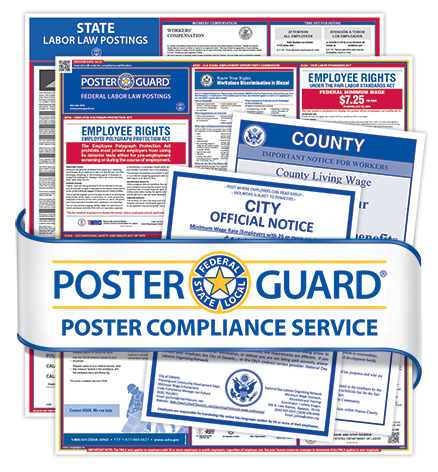Any education on minimum wage begins with the fact that the federal minimum wage hasn’t increased since July 2009. It has idled at $7.25 an hour for nearly a decade and a half. It’s a very different situation at the state and local levels, however. To uphold the legal requirements, you. must keep up with changing rates, pay the most generous rate to affected workers, and display all applicable federal, state and local postings at the workplace (even if the rates vary).
Here are some frequently asked questions regarding minimum wage compliance for businesses:
Minimum Wage Basics: What You Need to Know
Basically, the minimum wage is the lowest allowable rate of pay for employees under the Fair Labor Standards Act (FLSA). Its purpose is to create a ‘fair’ base pay rate for employees and protect them from economic shifts. The federal minimum wage remains at $7.25 per hour and does not increase automatically. Rather, Congress must pass a bill and the President sign it into law for a rate boost.
How is the minimum wage determined?
This is a complex topic to summarize, but the Consumer Price Index (CPI) plays a big role in the minimum wage for any given state, county or city. The CPI is a measurement of the average change in prices paid for a collection of consumer goods and services, such as transportation, food and medical care. For government agencies, the CPI can act as a solid indicator of where prices are going, as well as how much a dollar of income will purchase. (Similarly, employers may use the CPI as a benchmark for determining annual cost-of-living adjustments.)
Since 1938, the federal minimum wage has increased 22 times — from 25 cents an hour to the current rate of $7.25 an hour.
How has the minimum wage changed historically?
The first attempt at a federal minimum wage was in 1933 as part of President Franklin D. Roosevelt’s New Deal. But two years later, the U.S. Supreme Court declared the minimum wage unconstitutional and abolished it. It wasn’t until 1938 that an official minimum wage was enacted, when President Roosevelt signed the FLSA into law. This legislation created a wage of 25¢ /hour to maintain a “minimum standard of living necessary for health, efficiency and general well-being.”
Further developments through the years included:
- 1949 – minimum wage nearly doubles from 40¢ to 75¢//hour
- 1961 – coverage expands to the retail trade industry
- 1960 – a milestone year when the minimum wage achieves its peak buying power at $1.60/hour
- 1977 – new amendments eliminate the separate (and lower) minimum wage for large agricultural employers, establishing a uniform minimum wage for all covered workers
- 1981-1990 – minimum wage remains at $3.35/hour, a record-setting wage freeze for the time
- 1997-2007 – minimum wage remains at $5.15/hour, breaking the previous wage freeze record
- 1997 – President Clinton introduces legislation allowing states to set their own minimum wage rates
- 2009 – minimum wage increases to $7.25/hour in the last of three incremental raises under the Fair Minimum Wage Act of 2007
- 2014 – President Obama signs an executive order raising the minimum wage for federal contractors to $10.10/hour
- 2023 – 30 states plus D.C. have higher rates than federal law; certain federal contractors must pay workers $16.20/hour
Are there any exceptions to paying the minimum wage?
Minimum wage exceptions only apply under specific circumstances. These exceptions cover workers with disabilities, full-time students, youth under age 20 in their first 90 consecutive calendar days of employment, tipped employees and student learners.
Who enforces the minimum wage?
The Department of Labor’s (DOL) Wage and Hour Division administers and enforces the federal minimum wage law.
How often do state and local minimum wages change?
We are witnessing a steady trend of state and local legislators enacting higher minimum wages than the federal rate, typically at the first of the year or mid-year. As of January 2023, 22 states plus Washington, D.C. raised their minimum wages, with four more states following suit later in the year. Currently, 30 states and Washington, D.C. have higher minimum wages than federal law. Approximately 13 more states will experience minimum wage increases of $15/hour and above in 2023.
What if rates vary at the federal, state and local levels?
The key factor regarding the web of minimum wages is that when the federal, state or local rates vary, you’re legally required to pay the most generous rate to non-exempt employees.
What about workplace postings?
You’re at risk of non-compliance if your workplace labor law postings don’t reflect the latest minimum wage increases. You must post a current FLSA/Federal Minimum Wage poster where all employees can see it, as well as state and local postings for any areas with higher minimum wages than the federal rate.
How can I possibly keep up?
We can help! The Minimum Wage Monitor™ Premium Service provides current, past and future minimum wage rates by state, county and city for all 50 states, plus the District of Columbia and Puerto Rico. The service includes an interactive, color-coded map with real-time data maintained by our in-house legal team, as well as automated email notifications whenever minimum wage laws are passed or change.
We also make it easy to comply with the latest posting requirements. Poster Guard® Poster Compliance Service guarantees your business will stay compliant with federal, state and local posting requirements (including the mandatory FLSA/Federal Minimum wage poster) all year long, for one annual fee. Once enrolled, you’ll immediately receive a complete federal/state/county/city poster set, plus automatic replacement posters any time a mandatory change occurs for a full 12 months. Backed by an expert legal team, this comprehensive posting solution offers 365 days of hassle-free labor law posting compliance.



